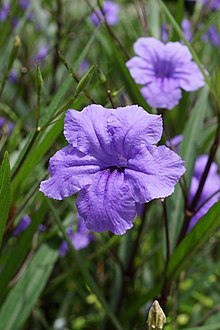Loading AI tools
Species of flowering plant From Wikipedia, the free encyclopedia
Ruellia simplex, the Mexican petunia, Mexican bluebell or Britton's wild petunia, is a species of flowering plant in the family Acanthaceae. It is a native of Mexico, the Caribbean, and South America. It has become a widespread invasive plant in Florida, where it was likely introduced as an ornamental before 1933,[1][2] as well as in the eastern Mediterranean, South Asia and other parts of the eastern hemisphere.
| Ruellia simplex | |
|---|---|
 | |
| Scientific classification | |
| Kingdom: | Plantae |
| Clade: | Tracheophytes |
| Clade: | Angiosperms |
| Clade: | Eudicots |
| Clade: | Asterids |
| Order: | Lamiales |
| Family: | Acanthaceae |
| Genus: | Ruellia |
| Species: | R. simplex |
| Binomial name | |
| Ruellia simplex | |
| Synonyms | |
|
See text | |
Ruellia simplex C.Wright is the oldest and accepted name for this species, which has been variously called Ruellia angustifolia (Nees) Lindau, Ruellia brittoniana Leonard, and Cryphiacanthus angustifolius Nees, among several synonyms.[3] The genus is named after French botanist Jean Ruel, while the specific name refers to the simple, not compound leaves.[4]
Ruellia simplex is an evergreen perennial growing 3 ft (0.91 m) tall, forming colonies of stalks with lance-shaped leaves that are 6 to 12 in (15 to 30 cm) long and .5 to .75 in (1.3 to 1.9 cm) wide.
The flowers are metallic blue to purple, trumpet-shaped with an about 2 in (5.1 cm)-wide, five-lobed corolla. There is a dwarf variety that is only 1 ft (0.30 m) tall.[1]
Ruellia simplex is native to Mexico, the West Indies, western Bolivia, southwestern Brazil, Paraguay, Uruguay, and northeastern Argentina. It has been widely used as an ornamental plant and has escaped from cultivation in the United States, Australia and parts of Asia, as well as several Pacific Islands. It is one of the most common landscape plants in Dubai.[5]
It has become invasive in some of these areas, forming dense, single-species stands of vegetation which threaten native plants. It is mainly a plant of wet places such as ditches, pond verges, lakesides and marshes, but can survive in drier conditions.[6]
The University of Florida's Institute of Food and Agricultural Sciences is trying to reduce the number of home gardeners who plant R. simplex by recommending alternatives, especially Silphium asteriscus, Sisyrinchium angustifolium, Stachytarpheta jamaicensis, Stokesia laevis, but also including some R. simplex cultivars that are sterile.[7]
Seamless Wikipedia browsing. On steroids.
Every time you click a link to Wikipedia, Wiktionary or Wikiquote in your browser's search results, it will show the modern Wikiwand interface.
Wikiwand extension is a five stars, simple, with minimum permission required to keep your browsing private, safe and transparent.